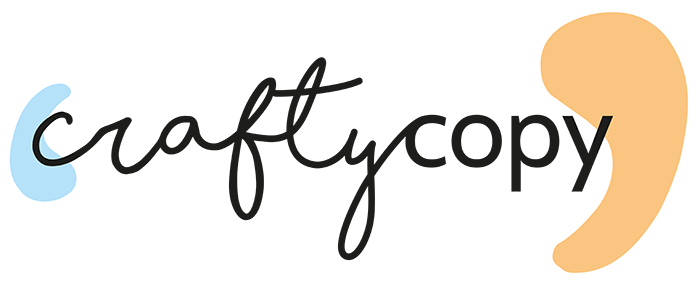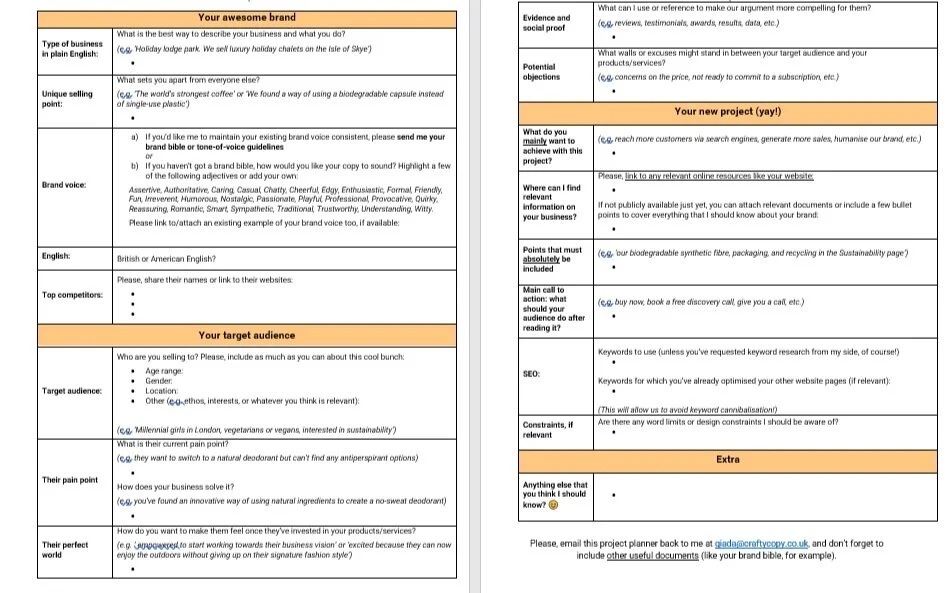How to Write a Copywriting Brief that Actually Helps [+ Template]
Yes, you must know how to write a copywriting brief if you’re planning on working with a copywriter.
Don’t you dare think that you can just tell us to ‘write a blog post on this keyword’ or ‘just freshen up our current website copy’. DON’T. YOU. DARE.
That’s a one-way ticket to
1) receiving vague words without an actual strategy or goal
2) making a copywriter want to bash their head against the keyboard
Don’t worry, though: learning how to write a copywriting brief isn’t hard at all, especially with my examples and FREE copywriting brief template.
But let’s start from the basics before you get the urge of telling a writer “can you not just figure these things out on your own?”
What is a creative brief in copywriting?
In copywriting, a creative brief is simply a document that clients must prepare or fill up in order to provide the writer with all the information they need to complete a project.
A good brief will cover everything from company information to their target audience and more specific details about the actual project and its goals.
I personally prefer the term project planner, but we’re gonna stick to copywriting brief for the sake of consistency, yeah?
Why you ABSOLUTELY need a copywriting brief
“Wait, I have to answer so many questions and fill up an entire document? That sounds time-consuming!”
Well, if you think that filling a copywriting brief is time-consuming, consider how much time (and money) you’d waste without one!
If you don’t give enough information to your copywriter, they won’t be able to fully understand your business, how you’re different from your competitors, and why your target customers can’t afford to miss out on you.
And if your copywriter doesn’t get it, neither will your audience.
’Cause here’s the thing:
you’re probably taking waaaaaay too many things for granted since it’s your own business and you know it like the back of your favourite coffee mug.
But these things aren’t that obvious to someone reading about it for the first time.
Without a brief, there’s plenty of room for misunderstanding.
When you learn how to write a copywriting brief correctly, on the other hand, your writer will understand the actual ‘why’ behind your business and, most importantly, how to repackage it for your dream customers to fall in love with it.
Here’s a little spoiler: not everything you write in the brief will end up on your final draft, but a copywriter still needs it to get the bigger picture.
It’s almost like planning a fantasy novel. You probably won’t describe every single feature about your world and how its currency or magic works. But you should still know all that. If you haven’t thought about it, your readers will probably be able to tell that something is off.
What does a copywriting brief look like?
A copywriting brief is usually a Google Docs or Word document (or an equivalent) with some points or questions and room for answering them. Pretty straightforward, right?
Here’s a copywriting brief example:
If you’re planning on working with several copywriters on an ongoing basis, you should consider creating a standard template so that you can save yourself some time
If, on the contrary, you’re mainly looking for a standalone project or one trusted writer to collaborate with, here’s the best news: most professional copywriters already have their own copywriting brief template (like yours truly), so all you have to do is… fill it in when they send it to you!
How do you write a copywriting brief? 3 areas to provide info on
If you were hoping for some copywriting brief examples or a template, your virtual prayers have been answered. You can literally download my free project planner sample before the end of this article.
However, to learn how to write a copywriting brief from scratch or to fully understand why I’m asking for specific things, keep on reading.
1. Information about your business
Company name
Contact details (unless already disclosed when arranging the first payment)
Type of business in plain English: what is the best way to describe your business and what you do?
(e.g. ‘Holiday lodge park. We sell luxury holiday chalets on the Isle of Skye’)Unique selling proposition: what sets you apart from everyone else?
(e.g. ‘The world’s strongest coffee’ or ‘We found a way of using a biodegradable capsule instead of single-use plastic’)Brand voice: if you have a brand bible or tone-of-voice guidelines and a link to an example of them (e.g. on your website), send them to your copywriter. If not, you can describe how you’d like your copy to sound with adjectives like
Assertive, Authoritative, Caring, Casual, Chatty, Cheerful, Edgy, Enthusiastic, Formal, Friendly, Fun, Irreverent, Humorous, Nostalgic, Passionate, Playful, Professional, Provocative, Quirky, Reassuring, Romantic, Smart, Sympathetic, Traditional, Trustworthy, Understanding, Witty
Top competitors: link to their websites
2. Information about your audience
Target audience: Who are you selling to? Include as much as you can about this cool bunch, such as age range, gender, location, and more (like ethos, interests, or whatever you think is relevant)
(e.g. ‘Millennial girls in London, vegetarians or vegans, interested in sustainability’)
Their pain point: what is their current pain point? Why are they looking for what you offer?
(e.g. they want to switch to a natural deodorant but can’t find any antiperspirant options)
How does your business solve it?
(e.g. you’ve found an innovative way of using natural ingredients to create a no-sweat deodorant)
How your offer solves them: how do you want to make them feel once they’ve invested in your products/services?
(e.g. ‘ empowered to start working towards their business vision’ or ‘excited because they can now enjoy the outdoors without giving up on their signature fashion style’)Evidence and social proof: what can I use or reference to make our argument more compelling for them?
(e.g. reviews, testimonials, awards, results, data, etc.)
Potential objections: what walls or excuses might stand in between your target audience and your products/services?
(e.g. concerns on the price, not ready to commit to a subscription, etc.)
3. The actual copywriting project
What do you mainly want to achieve with this project?
(e.g. reach more customers via search engines, generate more sales, humanise our brand, etc.)Where can I find relevant information on your business? You can link to relevant online resources (like your website), send documents, or explain it in the actual copywriting brief
Points that must absolutely be included: copywriters can’t read minds (yet!), so it’s a bit unfair to go ‘oh, but you didn’t mention this extremely specific point’ if you haven’t requested it
(e.g. ‘our biodegradable synthetic fibre, packaging, and recycling in the Sustainability page’)Main call to action: what should your audience do after reading it?
(e.g. buy now, book a free discovery call, give you a call, etc.)SEO: if you’re providing the keywords, this is the time and place to do it. If you’re paying your copywriter for keyword research, you should still let them know what keywords you’ve already used on other website pages, if relevant. This will allow you to avoid keyword cannibalisation
Constraints, if relevant: are there any word limits or design constraints that your copywriter should be aware of?
Extra: you’re always welcome to add anything else that you think could be helpful
So, this is how to write a copywriting brief.
Once again, some points might change slightly depending on who you work with and what type of project you’ve agreed on, but this structure will work in most cases.
Free copywriting brief template: save yourself (and your writer) a headache
As promised, you can download this simple copywriting brief template, too.
[Disclaimer: this copywriting brief template is just an example and a starting point. When you actually work with me, I’ll ask you many more questions depending on the type of project]
Need words for your badass female-founded brand? Let’s collaborate!
Did you want to learn how to write a copywriting brief because you’re after some spanking new website copy or blog posts for your women-founded business?
Not only are you in the right place: you already have an idea of what my copywriting brief template looks like (you’re basically living in the future).
My core services to turn ambitious female entrepreneurs like you into THE go-to solution in their dream audience’s eyes:
Website copywriting: new website copy that simplifies your message, attracts your dream customers through Google, and turns more visits into leads and sales
Blog writing: stop wasting time writing blog posts that don't drive results! Instead, start generating more relevant traffic and leads while establishing yourself as an expert in your field
Now that you already know how to write a copywriting brief (or, in our case, how to fill it up once you receive it), just tell me more about your current challenges so that I can help you solve them with the right words.






